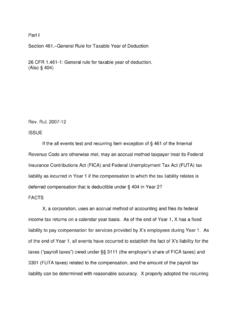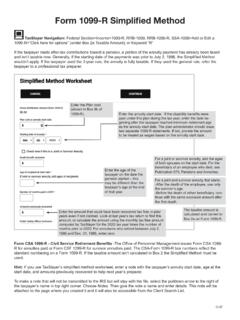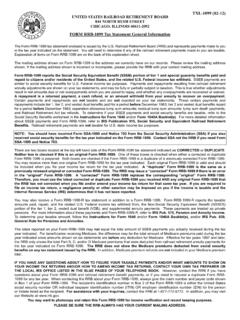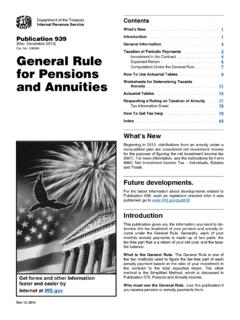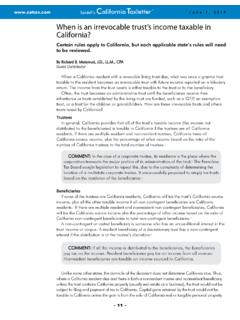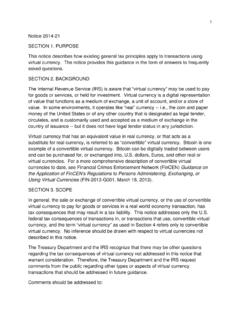Transcription of In general. taxpayers of up to 20 percent of the taxpayer ...
1 1 26 CFR : Trade or Business (Also: 199A) Rev. Proc. 2019-38 SECTION 1. PURPOSE This revenue procedure provides a safe harbor under which a rental real estate enterprise will be treated as a trade or business for purposes of section 199A of the Internal revenue Code (Code) and through of the Income Tax Regulations (26 CFR Part I). The safe harbor provided by this revenue procedure applies solely for purposes of section 199A. If an enterprise fails to satisfy the requirements of this safe harbor, it may be treated as a trade or business for purposes of section 199A if the enterprise otherwise meets the definition of trade or business in (b)(14). SECTION 2. BACKGROUND .01 In general . Section 199A was enacted on December 22, 2017, as part of the Tax Cut and Jobs Act, Pub.
2 L. 115-97, and was amended on March 23, 2018, retroactively to January 1, 2018, by the Consolidated Appropriations Act, 2018, Pub. L. 115-141. Congress enacted section 199A to provide a deduction to non-corporate taxpayers of up to 20 percent of the taxpayer s qualified business income from each of 2 the taxpayer s qualified trades or businesses, including those operated through a partnership, S corporation, or sole proprietorship, as well as a deduction of up to 20 percent of aggregate real estate investment trust dividends and qualified publicly traded partnership income..02 Trade or business. Section 199A(d) defines a qualified trade or business as any trade or business other than a specified service trade or business (SSTB) or a trade or business of performing services as an employee.
3 Section (b)(14) defines trade or business for purposes of section 199A as a trade or business under section 162 other than the trade or business of performing services as an employee. In addition, (b)(14) provides that rental or licensing of tangible or intangible property (rental activity) that does not rise to the level of a section 162 trade or business is nevertheless treated as a trade or business for purposes of section 199A, if the property is rented or licensed to a trade or business conducted by the individual or a relevant passthrough entity (RPE) which is commonly controlled under Sections (b) and (d) define an SSTB and the trade or business of performing services as an employee, respectively..03 Notice 2019-07. The Treasury Department and the IRS are aware that whether an interest in rental real estate rises to the level of a trade or business for purposes of section 199A is the subject of uncertainty for some taxpayers .
4 To help mitigate this uncertainty, a proposed version of a revenue procedure containing a safe harbor for treating a rental real estate enterprise as a trade or business solely for purposes of section 199A was released for public comment in Notice 2019-07, 2019-09 IRB 740. This revenue procedure is issued following consideration of all public 3 comments received by the IRS and the Treasury Department and sets forth the safe harbor and the procedural requirements for using it. SECTION 3. RULES OF APPLICATION .01 In general . This safe harbor is available to taxpayers who seek to claim the deduction under section 199A with respect to a rental real estate enterprise as defined in section If the safe harbor requirements are met, the rental real estate enterprise will be treated as a single trade or business as defined in section 199A(d) for purposes of applying the regulations under section 199A, including the application of the aggregation rules in RPEs, as defined in (b)(10), may also use this safe harbor.
5 In order to rely upon the safe harbor, taxpayers and RPEs must satisfy all of the requirements of this revenue procedure. Failure to satisfy the requirements of this safe harbor does not preclude a taxpayer or the Service from otherwise establishing that an interest in rental real estate is a trade or business for purposes of section 199A..02 Rental real estate enterprise. Solely for purposes of this safe harbor, a rental real estate enterprise is defined as an interest in real property held for the production of rents and may consist of an interest in a single property or interests in multiple properties. The taxpayer or RPE relying on this revenue procedure must hold each interest directly or through an entity disregarded as an entity separate from its owner under any provision of the Code.
6 Except for those property interests described in paragraph .05 of this section, taxpayers and RPEs may either treat each interest in similar property held for the production of rents as a separate rental real estate enterprise or treat interests in all similar properties held for the production of rents as a single rental real estate 4 enterprise. For purposes of applying this revenue procedure, properties held for the production of rents are similar if they are part of the same rental real estate category. The two types of rental real estate categories for the purpose of combining properties into a single rental real estate enterprise are residential and commercial. Thus, commercial real estate held for the production of rents may only be part of the same enterprise with other commercial real estate, and residential properties may only be part of the same enterprise with other residential properties.
7 Once a taxpayer or RPE treats interests in similar commercial properties or similar residential properties as a single rental real estate enterprise under the safe harbor, the taxpayer or RPE must continue to treat interests in all similar properties, including newly acquired properties, as a single rental real estate enterprise when the taxpayer or RPE continues to rely on the safe harbor. However, a taxpayer or RPE that chooses to treat its interest in each residential or commercial property as a separate rental real estate enterprise may choose to treat its interests in all similar commercial or all similar residential properties as a single rental real estate enterprise in a future year . An interest in mixed-use property may be treated as a single rental real estate enterprise or may be bifurcated into separate residential and commercial interests.
8 For purposes of this revenue procedure, mixed-use property is defined as a single building that combines residential and commercial units. An interest in mixed-use property, if treated as a single rental real estate enterprise, may not be treated as part of the same enterprise as other residential, commercial, or mixed-use property. Each rental real estate enterprise that satisfies the requirements of this safe harbor is treated as a separate trade or business for purposes of applying section 199A 5 and the regulations thereunder..03 Safe harbor. The determination to use this safe harbor must be made annually. Solely for the purposes of section 199A, each rental real estate enterprise will be treated as a single trade or business if the following requirements are satisfied during the taxable year with respect to the rental real estate enterprise: (A) Separate books and records are maintained to reflect income and expenses for each rental real estate enterprise.
9 If a rental real estate enterprise contains more than one property, this requirement may be satisfied if income and expense information statements for each property are maintained and then consolidated; (B) For rental real estate enterprises that have been in existence less than four years, 250 or more hours of rental services are performed (as described in this revenue procedure) per year with respect to the rental real estate enterprise. For rental real estate enterprises that have been in existence for at least four years, in any three of the five consecutive taxable years that end with the taxable year , 250 or more hours of rental services are performed (as described in this revenue procedure) per year with respect to the rental real estate enterprise; and (C) The taxpayer maintains contemporaneous records, including time reports, logs, or similar documents, regarding the following: (i) hours of all services performed; (ii) description of all services performed; (iii) dates on which such services were performed; and (iv) who performed the services.
10 If services with respect to the rental real estate enterprise are performed by 6 employees or independent contractors, the taxpayer may provide a description of the rental services performed by such employee or independent contractor, the amount of time such employee or independent contractor generally spends performing such services for the enterprise, and time, wage, or payment records for such employee or independent contractor. Such records are to be made available for inspection at the request of the IRS. (D) The taxpayer or RPE attaches a statement to a timely filed original return (or an amended return for the 2018 taxable year only) for each taxable year in which the taxpayer or RPE relies on the safe harbor. An individual or RPE with more than one rental real estate enterprise relying on this safe harbor may submit a single statement but the statement must list the required information separately for each rental real estate enterprise.










